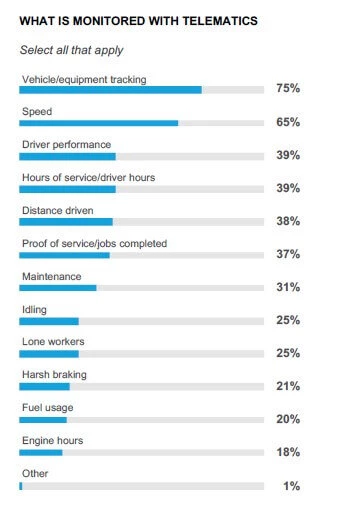During the Covid-19 pandemic, business as usual has rapidly changed across New Zealand. While essential businesses are working overtime to meet fluctuating demands in a rapidly changing regulatory situation, others have seen demand drop off and find they have time to look at training and strategy. No matter the business, it’s important to make good use of the technology available to support operations.
Transport operators and commercial fleets of all shapes and sizes have installed GPS-based vehicle tracking systems. However, our research uncovered that these systems are not being used to their full potential as many features are being overlooked. Our Telematics Benchmark Report found that, on average, businesses used only 3 out of the 12 tested features of the vehicle management system.
From the research results, this shows that businesses can learn more about the capabilities of vehicle tracking software to maximise utilisation within the operation. Fleet operators and managers are able to talk to industry and solutions specialists, undertake online training, or look at case studies of similar businesses to gain a better understand or how the system’s use can be expanded throughout. With better use of tracking software, businesses can find further cost reductions and efficiencies - such as reducing fuel use or running an improved preventative maintenance system - to maximise your return on investment.


Take advantage of these three under-used features of a vehicle tracking system
Maintenance
A GPS-based fleet management system is incredibly useful to keep maintenance all in one place. By keeping track of the distance a vehicle has travelled, fleet managers can make sure that their maintenance schedule is in direct response to a vehicle’s use. This feature is particularly useful when vehicle use and regular timetables are disrupted.
The maintenance team can also set up email or system alerts to signal when a vehicle’s certificate of fitness (CoF), Warrant of fitness (WoF) or registration is about to expire – and ensure maintenance and certification is done in good time to reduce the vehicle’s downtime.
Drivers can use the in-cab device to complete a digital checklist of the vehicle and send any images of areas of concern to the workshop. This saves the workshop chasing down drivers at the end of a long day.

Fuel usage
This is perhaps the most beneficial feature to use when it comes to cost control and reducing costs. Our Telematics Benchmark Survey found that of the businesses that monitor fuel use, half of them decreased the fleet’s fuel consumption. The average decrease in fuel use was 13% since implementing in-vehicle telematics.
Benchmarking and understanding fuel use will help businesses to find efficiencies in the fleet and make more data-based decisions about future operations, costs and vehicle use. This function remains largely untapped for many businesses that have telematics systems installed.
Idling
One of the fastest and simplest ways to reduce fuel costs is to eliminate unnecessary idling. The US Department of Energy found that idling a heavy truck consumes about 4.5 litres of fuel per hour. A number of Teletrac Navman customers who checked idling in their fleet were surprised to find that drivers idled for quite long periods of time – upwards of 15 minutes. The drivers were just as surprised themselves, which means it’s an unconscious habit that’s not easily reduced by the drivers alone. With a vehicle tracking software, a business can set up alerts for excessive idling to notify the fleet manager. Alternatively, businesses can run reports on individual vehicles and drivers to see when, where and who is idling. Understanding the reasons for idling, can assist businesses in working with their drivers to reduce it.
Knowledge is power, so we hope that you feel a lot more confident in trying some new features in your vehicle tracking system.

